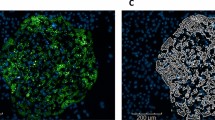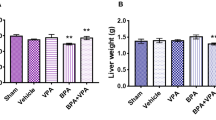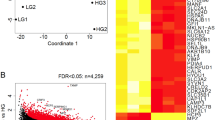Abstract
Aim:
To investigate the potential interactive effects of a high-fat diet (HFD) and valproic acid (VPA) on hepatic steatosis and hepatotoxicity in rats.
Methods:
Male SD rats were orally administered VPA (100 or 500 mg·kg−1·d−1) combined with HFD or a standard diet for 8 weeks. Blood and liver samples were analyzed to determine lipid levels and hepatic function biomarkers using commercial kit assays. Low-molecular-weight compounds in serum, urine and bile samples were analyzed using a metabonomic approach based on GC/TOF-MS.
Results:
HFD alone induced extensive hepatocyte steatosis and edema in rats, while VPA alone did not cause significant liver lesions. VPA significantly aggravated HFD-induced accumulation of liver lipids, and caused additional spotty or piecemeal necrosis, accompanied by moderate infiltration of inflammatory cells in the liver. Metabonomic analysis of serum, urine and bile samples revealed that HFD significantly increased the levels of amino acids, free fatty acids (FFAs) and 3-hydroxy-butanoic acid, whereas VPA markedly decreased the levels of amino acids, FFAs and the intermediate products of the tricarboxylic acid cycle (TCA) compared with the control group. HFD aggravated VPA-induced inhibition on lipid and amino acid metabolism.
Conclusion:
HFD magnifies VPA-induced impairment of mitochondrial β-oxidation of FFAs and TCA, thereby increases hepatic steatosis and hepatotoxicity. The results suggest the patients receiving VPA treatment should be advised to avoid eating HFD.
Similar content being viewed by others
Log in or create a free account to read this content
Gain free access to this article, as well as selected content from this journal and more on nature.com
or
References
Simon D, Penry JK . Sodium Di-N-propylacetate (DPA) in the treatment of epilepsy. Epilepsia 1975; 16: 549–73.
Chapman A, Keane PE, Meldrum BS, Simiand J, Vernieres JC . Mechanism of anticonvulsant action of valproate. Prog Neurobiol 1982; 19: 315–59.
Chavez-Blanco A, Segura-Pacheco B, Perez-Cardenas E, Taja-Chayeb L, Cetina L, Candelaria M . Histone acetylation and histone deacetylase activity of magnesium valproate in tumor and peripheral blood of patients with cervical cancer. A phase I study. Mol Cancer 2005; 4: 22.
Goodyear O, Agathanggelou A, Novitzky-Basso I, Siddique S, McSkeane T, Ryan G, et al. Induction of a CD8+ T-cell response to the MAGE cancer testis antigen by combined treatment with azacitidine and sodium valproate in patients with acute myeloid leukemia and myelodysplasia. Blood 2010; 116: 1908–18.
Eadie MJ, Hooper WD, Dickinson RG . Valproate-associated hepatotoxicity and its biochemical mechanisms. Med Toxicol Adverse Drug Exp 1988; 3: 85–106.
Tong V, Teng XW, Chang TK, Abbott FS . Valproic acid I: time course of lipid peroxidation biomarkers, liver toxicity, and valproic acid metabolite levels in rats. Toxicol Sci 2005; 86: 427–35.
Luef GJ, Waldmann M, Sturm W, Naser A, Trinka E, Unterberger I, et al. Valproate therapy and nonalcoholic fatty liver disease. Ann Neurol 2004; 55: 729–32.
Becker CM, Harris RA . Influence of valproic acid on hepatic carbohydrate and lipid metabolism. Arch Biochem Biophys 1983; 223: 381–92.
Coudé FX, Grimber G, Pelet A, Benoit Y . Action of the antiepileptic drug, valproic acid, on fatty acid oxidation in isolated rat hepatocytes. Biochem Biophys Res Commun 1983; 115: 730–6.
Pessayre D, Mansouri A, Haouzi D, Fromenty B . Hepatotoxicity due to mitochondrial dysfunction. Cell Biol Toxicol 1999; 15: 367–73.
Knapp AC, Todesco L, Beier K, Terracciano L, Sägesser H, Reichen J, et al. Toxicity of valproic acid in mice with decreased plasma and tissue carnitine stores. J Pharmacol Exp Ther 2008; 324: 568–75.
Oguma T, Yamada H, Sawaki M, Narita N . Pharmacokinetic analysis of the effects of different foods on absorption of cefaclor. Antimicrob Agents Chemother 1991; 35: 1729–35.
OSullivan A, Gibney MJ, Brennan L . Dietary intake patterns are reflected in metabolomic profiles: potential role in dietary assessment studies. Am J Clin Nutr 2011; 93: 314–21.
Bellentani S, Saccoccio G, Masutti F, Crocè LS, Brandi G, Sasso F . Prevalence and risk factors for hepatic steatosis in northern Italy. Ann Intern Med 2002; 132: 112–7.
de Alwis NM, Day CP . Non-alcoholic fatty liver disease: the mist gradually clears. J Hepatol 2008; 48: S104–12.
Satia-Abouta J, Patterson RE, Schiller RN, Kristal AR . Energy from fat is associated with obesity in US men: results from the Prostate Cancer Prevention Trial. Prev Med 2002; 34: 493–501.
Fan JG, Farrell GC . Epidemiology of non-alcoholic fatty liver disease in China. J Hepatol 2009; 50: 204–10.
Angulo P . Nonalcoholic fatty liver disease. N Engl J Med 2002; 346: 1221–31.
Li H, Xie Z, Lin J, Song H, Wang Q, Wang K, et al. Transcriptomic and metabonomic profiling of obesity-prone and obesity-resistant rats under high fat diet. J Proteome Res 2011; 7: 4775–83.
Rector RS, Thyfault JP, Uptergrove GM, Morris EM, Naples SP, Borengasser SJ, et al. Mitochondrial dysfunction precedes insulin resistance and hepatic steatosis and contributes to the natural history of non-alcoholic fatty liver disease in an obese rodent model. J Hepatol 2010; 52: 727–36.
Verrotti A, Agostinelli S, Parisi P, Chiarelli F, Coppola G . Nonalcoholic fatty liver disease in adolescents receiving valproic acid. Epilepsy Behav 2011; 20: 382–5.
Nicholson JK, Lindon JC, Holmes E . 'Metabonomics': understanding the metabolic responses of living systems to pathophysiological stimuli via multivariate statistical analysis of biological NMR spectroscopic data. Xenobiotica 1999; 29: 1181–9.
Nicholson JK, Connelly J, Lindon JC, Holmes E . Metabonomics: a platform for studying drug toxicity and gene function. Nat Rev Drug Discov 2002; 1: 153–61.
Gu SH, A JY, Wang GJ, Zha WB, Yan B, Zhang Y, et al. Metabonomic profiling of liver metabolites by gas chromatography-mass spectrometry and its application to characterizing hyperlipidemia. Biomed Chromatoqr 2010; 24: 245–52.
Schnackenberg LK, Jones RC, Thyparambil S, Taylor JT, Han T, Tong W, et al. An integrated study of acute effects of valproic acid in the liver using metabonomics, proteomics, and transcriptomics platforms. OMICS 2006; 10: 1–14.
Barr J, Vazquez-Chantada M, Alonso C, Perez-Cormenzana M, Mayo R, Galán A, et al. Liquid chromatography-mass spectrometry-based parallel metabolic profiling of human and mouse model serum reveals putative biomarkers associated with the progression of nonalcoholic fatty liver disease. J Proteome Res 2010; 9: 4501–12.
Lee MH, Hong I, Kim M, Lee BH, Kim JH, Kang KS, et al. Gene expression profiles of murine fatty liver induced by the administration of valproic acid. Toxicol Appl Pharmacol 2007; 220: 45–59.
Perucca E . Pharmacological and therapeutic properties of valproate: a summary after 35 years of clinical experience. CNS Drugs 2002; 16: 695–714.
Lee MH, Kim M, Lee BH, Kim JH, Kang KS, Kim HL, et al. Subchronic effects of valproic acid on gene expression profiles for lipid metabolism in mouse liver. Toxicol Appl Pharmacol 2008; 226: 271–84.
Hakk H, Larsen G, Bergman A, Orn U . Metabolism, excretion and distribution of the flame retardant tetrabromobisphenol-A in conventional and bile-duct cannulated rats. Xenobiotica 2000; 30: 881–90.
Bachir-Cherif D, Blum D, Braendli-Baiocco A, Chaput E, Pacheco GC, Flint N, et al. Characterization of post-surgical alterations in the bile duct-cannulated rat. Xenobiotica 2011; 41: 701–11.
A JY, Hang Q, Wang GJ, Zha WB, Yan B, Ren H, et al. Global analysis of metabolites in rat and human urine based on gas chromatography/time-of-flight mass spectrometry. Anal Biochem 2008; 379: 20–6.
Liu LS, A JY, Wang GJ, Yan B, Zhang Y, Wang X, et al. Differences in metabolite profile between blood plasma and serum. Anal Biochem 2010; 406: 105–12.
Chen T, Xie G, Wang X, Fan J, Qiu Y, Zheng X, et al. Serum and urine metabolite profiling reveals potential biomarkers of human hepatocellular carcinoma. Mol Cell Proteomics 2011; 10: M110.004945.
A J, Trygg J, Gullberg J, Johansson AI, Jonsson P, Antti H, et al. Extraction and GC/MS analysis of the human blood plasma metabolome. Anal Chem 2005; 77: 8086–94.
Jonsson P, Johansson AI, Gullberg J, Trygg J, A JY, Grung B, et al. High-throughput data analysis for detecting and identifying differences between samples in GC/MS-based metabolomic analyses. Anal Chem 2005; 77: 5635–42.
Eriksson L, Johansson E, Kettaneh-Wold N . Multi- and megavariate data analysis principles and applications. 2001. Umetrics, Ume, Sweden.
Trygg J, Holmes E, Lundstedt T . Chemometrics in metabonomics. J Proteome Res 2007; 6: 469–79.
Eker C, Rydell R, Svanberg K, Andersson-Engels S . Multivariate analysis of laryngeal fluorescence spectra recorded in vivo. Lasers Surg Med 2001; 28: 259–66.
Zhang LF, Chu XM, Wang H, Xie H, Guo C, Cao LJ, et al. Dysregulations of UDP-glucuronosyltransferases in rats with valproic acid and high fat diet induced fatty liver. Eur J Pharmacol 2013; 721: 277–85.
Fromenty B, Pessayre D . Impaired mitochondrial function in microvesicular steatosis: effects of drugs, ethanol, hormones and cytokines. J Hepatol 1997; 26: 43–53.
Ponchault S, van Hoof F, Veitch K . In vitro effects of valproate and valproate metabolites on mitochondrial oxidations: relevance of CoA sequestration to the observed inhibitions. Biochem Pharmacol 1992; 43: 2435–42.
Silva MF, Ruiter JP, IJlst L, Jakobs C, Duran M, de Almeida IT, et al. Differential effect of valproate and its D2-and D4-unsaturated metabolites, on the b-oxidation rate of long-chain and medium-chain fatty acids. Chem-Biol Interact 2001; 137: 203–12.
Toye AA, Dumas ME, Blancher C, Rothwell AR, Fearnside JF, Wilder SP, et al. Subtle metabolic and liver gene transcriptional changes underlie diet-induced fatty liver susceptibility in insulin-resistant mice. Diabetologia 2007; 50: 1867–79.
Xie Z, Li H, Wang K, Lin J, Wang Q, Zhao G, et al. Analysis of transcriptome and metabolome profiles alterations in fatty liver induced by high-fat diet in rat. Metabolism 2010; 59: 54–60.
Becker CM, Harris RA . Influence of valproic acid on hepatic carbohydrate and lipid metabolism. Arch Biochem Biophys 1983; 223: 381–92.
Pourahmad J, Eskandari MR, Kaghazi A, Shaki F, Shahraki J, Fard JK . A new approach on valproic acid induced hepatotoxicity: involvement of lysosomal membrane leakiness and cellular proteolysis. Toxicol In Vitro 2012; 26: 545–51.
Krähenbühl L, Reichen J, Talos C, Krähenbühl S . Benzoic acid metabolism reflects hepatic mitochondrial function in rats with long-term extrahepatic cholestasis. Hepatology 1997; 25: 278–83.
Pie J, Casals N, Puisac B, Hegardt FG . Molecular basis of 3-hydroxy-3-methylglutaric aciduria. J Physiol Biochem 2003; 59: 311–21.
Koling S, Kalhoff H, Schauerte P, Lehnert W, Diekmann L . 3-hydroxy-3- methylglutaraciduria (case report of a female Turkish sisters with 3-hydroxy-3- methylglutaryl- Coenzyme A lyase deficiency. Klin Padiatr 2000; 212: 113–6.
Batetta B, Sanna F . Cholesterol metabolism during cell growth: Which role for the plasma membrane? Eur J Lipid Sci Technol 2006; 108: 687–99.
Sviridov D, Nestel P . Dynamics of reverse cholesterol transport: Protection against atherosclerosis. Atherosclerosis 2002; 161: 245–54.
Esteller A . Physiology of bile secretion. World J Gastroenterol 2008; 14: 5641–9.
Kolodziejczyk J, Saluk-Juszczak J, Wachowicz B . In vitro study of the antioxidative properties of the glucose derivatives against oxidation of plasma components. J Physiol Biochem 2011; 67: 175–83.
Mak IT, Komarov AM, Kramer JH, Weglicki WB . Protective mechanisms of Mg-gluconate against oxidative endothelial cytotoxicity. Cell Mol Biol 2000; 46: 1337–44.
Acknowledgements
This study was supported by the National Natural Science Foundation of China (Grants 81072695 and 91029746), the National Basic Research Program of China (“973 Program”) (Grant 2011CB505300-03), the Foundation for the Author of National Excellent Doctoral Dissertation of China (Grant 200979); the Natural Science Foundation of Jiangsu province (Grant BK2010066), and the Program for a New Century Excellent Talent in University (Grant NCET-09-0770).
Author information
Authors and Affiliations
Corresponding authors
Additional information
Supplemental Tables and Figures are available at the website of Acta Pharmacologica Sinica.
Supplementary information
Figure S1
Typical GC/TOFMS total ion current (TIC) chromatograms of rat serum. (DOC 771 kb)
Figure S2
Typical GC/TOFMS total ion current (TIC) chromatograms of rat urine. (DOC 895 kb)
Figure S3
Typical GC/TOFMS total ion current (TIC) chromatograms of rat bile. (DOC 331 kb)
Figure S4
Heatmap visualization of intervention effect of HFD and VAP based on the identified analytes in rat serum. (DOC 612 kb)
Figure S5
Heatmap visualization of intervention effect of HFD and VAP based on the identified analytes in rat urine. (DOC 621 kb)
Figure S6
Heatmap visualization of intervention effect of HFD and VAP based on the identified analytes in rat bile. (DOC 750 kb)
Table S1
Identified endogenous compounds from rat serum, urine and bile. (DOC 118 kb)
Table S2
Relative abundance of the identified analytes showing statistically significant differences from rat serum. (DOC 136 kb)
Table S3
Relative abundance of the identified analytes showing statistically significant differences from rat urine. (DOC 128 kb)
Table S4
Relative abundance of the identified analytes showing statistically significant differences from rat bile. (DOC 173 kb)
Rights and permissions
About this article
Cite this article
Zhang, Lf., Liu, Ls., Chu, Xm. et al. Combined effects of a high-fat diet and chronic valproic acid treatment on hepatic steatosis and hepatotoxicity in rats. Acta Pharmacol Sin 35, 363–372 (2014). https://doi.org/10.1038/aps.2013.135
Received:
Accepted:
Published:
Issue date:
DOI: https://doi.org/10.1038/aps.2013.135
Keywords
This article is cited by
-
Effect of anti-epileptic drugs usage on thyroid profile in Egyptian epileptic children
The Egyptian Journal of Neurology, Psychiatry and Neurosurgery (2024)
-
Micropatterned primary hepatocyte co-culture (HEPATOPAC) for fatty liver disease modeling and drug screening
Scientific Reports (2023)
-
Potential of the zebrafish (Danio rerio) embryo test to discriminate between chemicals of similar molecular structure—a study with valproic acid and 14 of its analogues
Archives of Toxicology (2022)
-
Valproate inhibits mitochondrial bioenergetics and increases glycolysis in Saccharomyces cerevisiae
Scientific Reports (2020)
-
NMR-based metabolomics in pediatric drug resistant epilepsy – preliminary results
Scientific Reports (2019)



